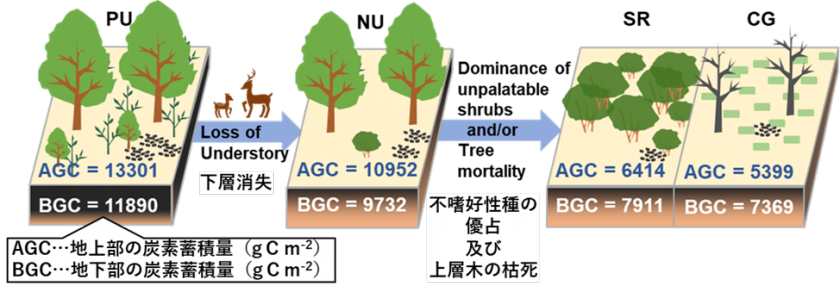Associate Professor Katayama and her research group found that the function of carbon storage in forest ecosystems is reduced by half due to an increase in deer.
First quantification of the effects of high-intensity deer foraging in natural forests
POINT
- In recent years, the deer population has been increasing throughout Japan, and in forests, high-intensity vegetation foraging has caused various changes in forest structure, including the decline of understory vegetation (*1), an increase in non-preferable plants, and increase in gap area.
- In the mountainous forests of Kyushu University's Miyazaki Reseach Forest (Shiiba Village), carbon stocks were measured in a forest area where forest structure had been altered by high-intensity deer foraging, and it was found that carbon stocks (*2) were reduced by about half at maximum compared to forest areas unaffected by deer foraging.
- The results of this study show for the first time that vegetation foraging by deer, which is becoming increasingly severe in Japan's forests, is degrading the forest's carbon dioxide storage function. This study also demonstrates the importance of deer forage countermeasures to mitigate future climate change.
SUMMARY
Forest ecosystems are expected to contribute to climate change mitigation by absorbing and storing carbon dioxide. However, in many natural forests in Japan, vegetation browsing by Japanese deer, whose population has increased, is now becoming more serious, resulting in the reduction of understory vegetation and its replacement by non-preferring plants to deer. In addition, the gap areas (*3) created by tree mortality are becoming bare because the renewal of juvenile trees is inhibited. However, it has not been clear how these changes in forest structure affect forest carbon stocks. A research group led by Hayato ABE, a doctoral student in the Graduate School of Bioresource and Environmental Sciences of Kyushu University, and Associate Professor Ayumi KATAYAMA and Professor Tomonori KUME of the Graduate School of Agriculture, Kyushu University, conducted a field survey in a mountain forest in the Miyazaki Research Forest of Kyushu University, where deer have been foraging for vegetation for a long time, and measured how much forest structure changes caused by deer reduced forest carbon stocks. The results showed that the forest carbon stocks in the Miyazaki Experiment Forest were reduced by about 30%. The results showed that the carbon stored in the ecosystem decreased by up to 49% when the mixed forest of beech and fir, which constitutes the natural forest of the Miyazaki Experimental Forest, was converted to acacia shrub forest, which is not preferred by deer, and to gap lands. This reduction in carbon stocks was attributed to the loss of medium- to large-sized upper trees due to inhibition of regeneration by juvenile trees, and to the loss of plant remains and soil organic matter deposited on the forest floor due to soil erosion caused by degradation of the understory vegetation. The results of this study suggest the need to control excessive vegetation foraging by deer in order to conserve natural forests and maintain ecosystem services.
The results of this study were published in the online preliminary version of the international journal Forest Ecology and Management on May 10, 2024.
COMMENTS
Deer vegetation foraging has increased in recent years in forests throughout Japan. Appropriate deer management is necessary when the intense vegetation foraging of deer negatively affects the public function of forest ecosystems. However, basic information on "how intense deer foraging affects the functioning of forest ecosystems" and "where it is most likely to be severe" is still scarce. This study found that deer foraging significantly reduces the amount of carbon that can be stored in mountain forests. Our research team will continue to study the impact of deer foraging on forest ecosystems and evaluate the conservation effects of deer countermeasures.

GLOSSARY
*1 understory vegetation
A general term for plants that cover the understory of a forest, such as young trees of low height, grasses, and shrubs.
*2 carbon stock
Carbon per area in an ecosystem (g C m-2). In forest ecosystems, carbon stocks are mainly composed of above-ground upper trees, understory vegetation, litter (plant remains) on the forest floor, and dead trees, and below-ground coarse roots, fine roots, and soil organic matter.
*3 gap areas
A space where light penetrates to the forest floor due to a gap in the forest canopy covering the forest caused by the death of the upper layer trees.
Paper Information
Publication:Forest Ecology and Management
Title: Reduction in forest carbon stocks by sika deer-induced stand structural alteration
Authors: Hayato ABE *、Tomonori KUME、Ayumi KATAYAMA
DOI:https://doi.org/10.1016/j.foreco.2024.121938
Research-related inquiries
Ayumi KATAYAMA, Associate Professor












 Contact
Contact
 Access Map
Access Map

